Experienced product designers deeply understand injection molding processes and consider numerous factors in plastic part design. This article focuses on essential elements such as wall thickness, draft angles, ribs, holes, pillars, snaps, interference fits, and tolerances in plastic molded part design.
Wall Thickness In Plastic Parts Design
Determining the appropriate wall thickness is crucial. Other features like ribs and fillets reference the wall thickness. The wall thickness of a plastic product depends on various requirements, including the external forces it must withstand, support for other parts, properties of the plastic material, weight, electrical performance, dimensional accuracy, stability, and assembly requirements.
Typically, the wall thickness for thermoplastic materials ranges from 1 to 6mm, with 2 to 3mm being most common. For larger parts, thicknesses can exceed 6mm. Table 1 shows recommended values for the wall thickness of various thermoplastics.
| Materiales | Minimum Wall Thickness | Recommended Values For Small Workpieces | Recommended Values For Medium Workpieces | Recommended Values For Large Workpieces |
| Nylon | 0.45 | 0.76 | 1.5 | 2.4~3.2 |
| PE | 0.6 | 1.25 | 1.6 | 2.4~3.2 |
| PS | 0.75 | 1.25 | 1.6 | 3.2~5.4 |
| PMMA | 0.8 | 1.5 | 2.2 | 4~6.5 |
| PVC | 1.2 | 1.6 | 1.8 | 3.2~5.8 |
| PP | 0.85 | 1.54 | 1.75 | 2.4~3.2 |
| PC | 0.95 | 1.8 | 2.3 | 3~4.5 |
| POM | 0.8 | 1.4 | 1.6 | 3.2~5.4 |
| ABS | 0.8 | 1 | 2.3 | 3.2~6 |
Uniformity of Wall Thickness
Uniform wall thickness is a key principle in plastic part design. Uneven thickness can cause inconsistent melt flow and cooling shrinkage, leading to defects like sink marks, voids, warping, or even cracking. It can also result in shrinkage marks, internal stresses, distortion, color variations, or differences in transparency. Thinner walls may compromise strength and rigidity during use and assembly. Economically, overly thick parts increase material costs and production time. Areas with thicker plastic cool slower, leading to sink marks. Figure 1 illustrates uniform wall thickness design.
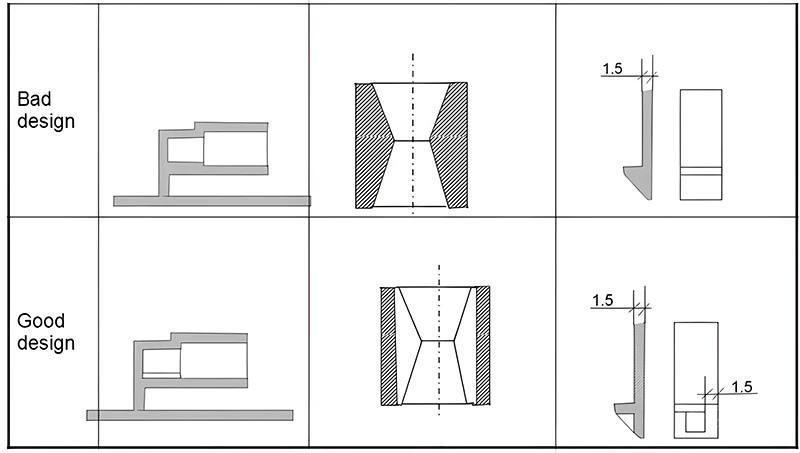
If a transition from thicker to thinner sections is unavoidable, it should be gradual, maintaining a maximum ratio of 3:1 in wall thickness, as shown in Figure 2.
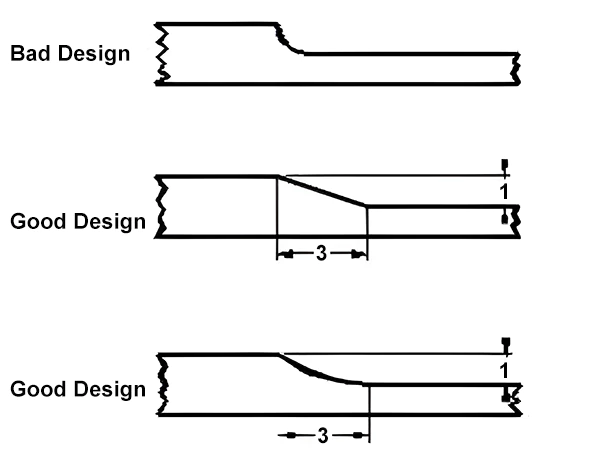
In many cases, designers can use ribs to modify the overall wall thickness, which not only saves material and reduces production costs but also shortens cooling time. Cooling time is approximately proportional to wall thickness.
Additionally, designers must consider the flow path, the distance the molten material travels from the gate to all parts of the cavity. Generally, there’s a proportional relationship between flow path and wall thickness. A larger wall thickness means a longer flow path. If the ratio of flow path to wall thickness is too high, material shortage or incomplete filling can occur far from the gate. Therefore, increasing wall thickness might be necessary in some cases.
Sharp Angles
Sharp angles often lead to defects and stress concentration in parts. These areas are prone to unwanted material accumulation during post-processing treatments like electroplating or painting. Stress concentration can cause fractures under load or impact. Therefore, it’s advisable to avoid sharp angles in design. Figure 3 provides an example of sharp angle design.
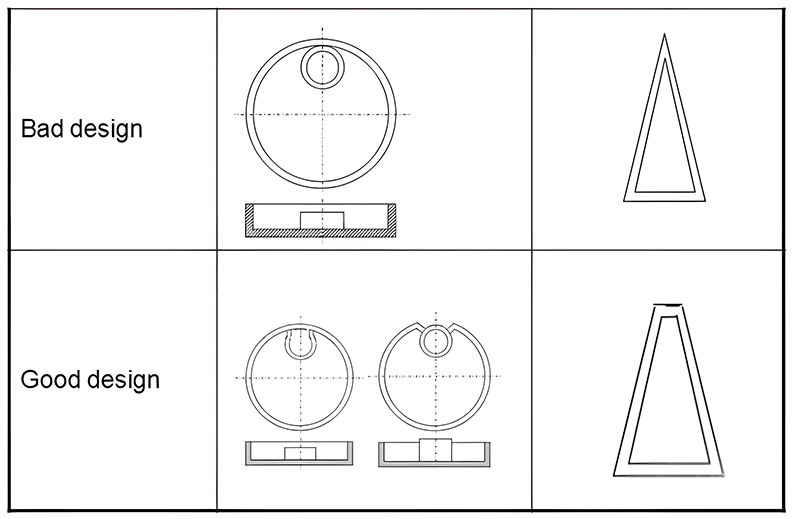
Draft Angles and Ejection Direction Considerations
Ejection Direction and Parting Line
At the onset of designing an injection-molded product, it’s crucial to establish the ejection direction and parting line. This ensures minimal core-pulling mechanisms and reduces the impact of parting lines on the appearance. Once the ejection direction is set, structures like ribs, snaps, and protrusions should align with it to avoid core pulling, reduce seam lines, and extend mold life. The appropriate parting line can then be chosen to enhance appearance and performance.
During ejection from the mold, the part must overcome ejection and opening forces. Opening refers to the part’s detachment from the cavity. As the part cools inside the mold, it shrinks, causing the hole walls to grip the core tightly. Friction between the part and core, vacuum adhesion at the hole bottom, and other factors make ejection forces significantly greater than opening forces. Excessive ejection forces can deform the part, cause whitening, wrinkling, and surface abrasions.
Draft Angles
Draft angles are crucial in determining the magnitude of ejection forces. Since injection-molded parts often adhere to the convex mold due to cooling shrinkage, equal draft angles on both concave and convex molds ensure uniform wall thickness and prevent the part from sticking to the hotter concave mold after ejection. In special cases where the part is required to stick to the concave mold post-ejection, the draft angle on the adjoining concave part can be reduced, or an undercut can be deliberately added to the concave mold.
There’s no fixed value for draft angles; they are usually determined based on experience. Highly polished outer walls can have draft angles as small as 1/8 or 1/4 degree. For deeper or textured parts, the draft angle should increase correspondingly. Conventionally, an additional 1 degree of draft angle is required for every 0.025mm depth of texture.
Moreover, while larger draft angles generally facilitate easier ejection, it’s vital to maintain dimensional accuracy. The dimensional errors caused by draft angles must stay within the precision range. For parts with significant shrinkage or complex shapes, larger draft angles should be considered.
Ribs in Plastic Part Design
The strength of plastic parts does not solely depend on increased wall thickness. In fact, increased thickness can lead to internal stresses due to shrinkage, thereby reducing strength. The key to enhancing the strength of plastic parts lies in their stiffness. This is often achieved through a combination of thin-wall styles and strategically placed ribs to increase the section modulus.
Rib Design Considerations
However, adding ribs results in increased thickness at the junction with the main wall. This thickness typically depends on the largest inscribed circle, determined by the rib thickness and the radius of the root fillet. With a base material thickness of 4mm, changing the rib thickness and root fillet radius alters the diameter of the largest inscribed circle. Figure 4 illustrates how local increases in wall thickness can lead to shrinkage deformation on the back, affecting the appearance. Proper design can reduce the likelihood of surface indentations, thus improving part quality.
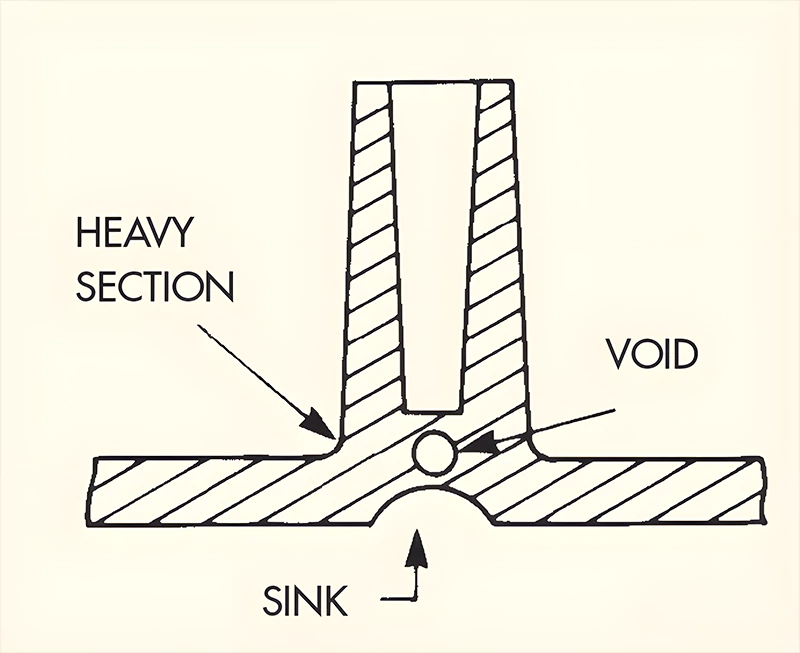
From the analysis, it’s evident that the thickness of the rib should be minimized within limits. If the rib is too thin, its height must be increased to maintain stiffness. However, excessively thin ribs can lead to deformation under pressure, difficulties in filling during molding, and sticking to the mold. The radius of the rib’s base should not be too small to avoid stress concentration.
Generally, the radius of the rib’s root should be at least 40% of the rib thickness. The rib thickness should be between 50% and 75% of the base material’s wall thickness, with the higher ratio limited to materials with low shrinkage rates. The height of the rib should be less than five times the thickness of the base material. Ribs must have draft angles and be oriented in the direction of ejection or use movable mold components. The spacing between ribs should be more than twice the thickness of the base material.
To achieve uniform stiffness in all directions, the simplest method is to add ribs both longitudinally and transversely, intersecting at right angles. However, this can increase wall thickness at intersections, leading to greater shrinkage. A common solution is to add a round hole at the intersection to create uniform wall thickness, as shown in Figure 5.
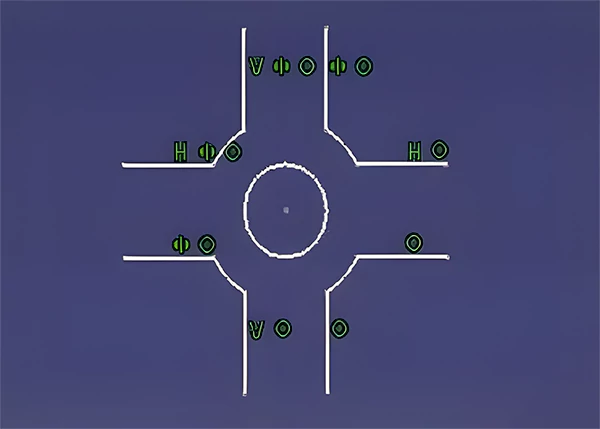
Plastic Parts Design Considerations for Holes
1. Hole Placement and Strength
Incorporating holes in plastic parts for assembly or functionality is common. The size and placement of these holes should ideally not compromise the product’s strength or add complexity to the manufacturing process. Key factors to consider:
- The distance between adjacent holes or between a hole and the nearest edge should be at least equal to the diameter of the hole. This is particularly important for holes near edges to prevent fracture. For threaded holes, the distance from the hole to the edge of the product should generally be more than three times the diameter of the hole.
2. Types of Holes
There are various types of holes, such as through holes, blind holes, and stepped holes. From an assembly perspective, through holes are more common and easier to produce than blind holes. In terms of mold design, through holes are structurally more straightforward. They can be formed with cores fixed in both the movable and fixed parts of the mold, or with a single core in either part. The former creates two cantilever beams under the action of the molten plastic, but with short arms, resulting in minimal deformation.
The latter, generally forming a simply supported beam, also has minimal deformation. When using two cores, their diameters should differ slightly to prevent misalignment and ensure smooth mating surfaces. Blind holes, formed with a cantilever beam core, are more prone to bending under the impact of the molten plastic, leading to irregularly shaped holes. Generally, the depth of a blind hole should not exceed twice its diameter. For blind holes with diameters of 1.5mm or less, the depth should not exceed the diameter. The wall thickness at the bottom of a blind hole should be at least one-sixth of the hole diameter to avoid shrinkage.
3. Side Holes
Side holes are typically formed using side cores, which can increase mold costs and maintenance, especially if the side cores are long and prone to breaking. If feasible, the design can be improved as shown in Figure 6, to mitigate these issues.
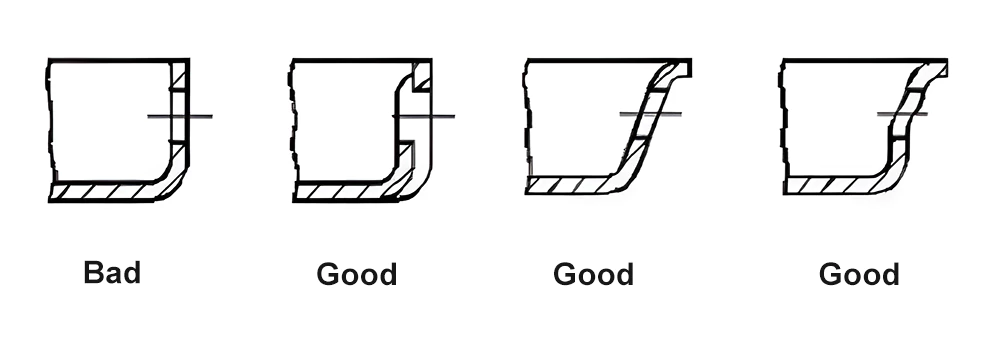
Bosses in Plastic Part Design
Bosses, typically protruding from the wall thickness, are used for assembling products, separating objects, and supporting other parts. Hollow bosses can accommodate inserts or tighten screws. These applications require sufficient strength to withstand pressure without cracking. Bosses are generally cylindrical, as this shape is easier to mold and offers better mechanical properties.
Integration with Structure
Lo ideal es que los resaltes no se diseñen como cilindros aislados. Deben conectarse a las paredes exteriores o utilizarse junto con nervaduras. Este enfoque aumenta la resistencia del saliente y facilita un flujo más suave del material plástico. La conexión a la pared exterior debe ser una conexión de pared delgada para evitar la contracción.
La base del resalte, donde se une con el material base, debe tener un radio de redondeo de 0,4 a 0,6 veces el espesor del material base. El grosor de la pared del resalte debe ser entre 0,5 y 0,75 veces el grosor del material base. La parte superior del resalte debe tener un chaflán para facilitar la instalación de los tornillos. También son necesarios ángulos de inclinación en los resaltes. Estos requisitos de diseño son similares a los de las costillas, por lo que los resaltes son una variante de las costillas. Consulte estas relaciones en las figuras 7 y 8.
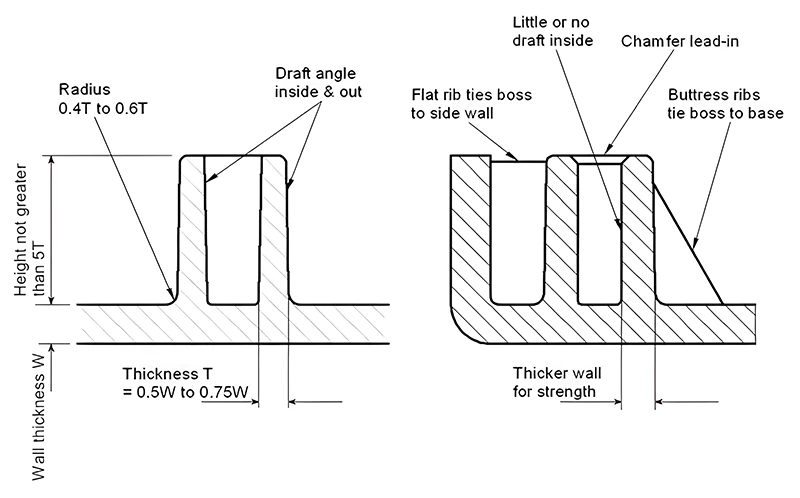
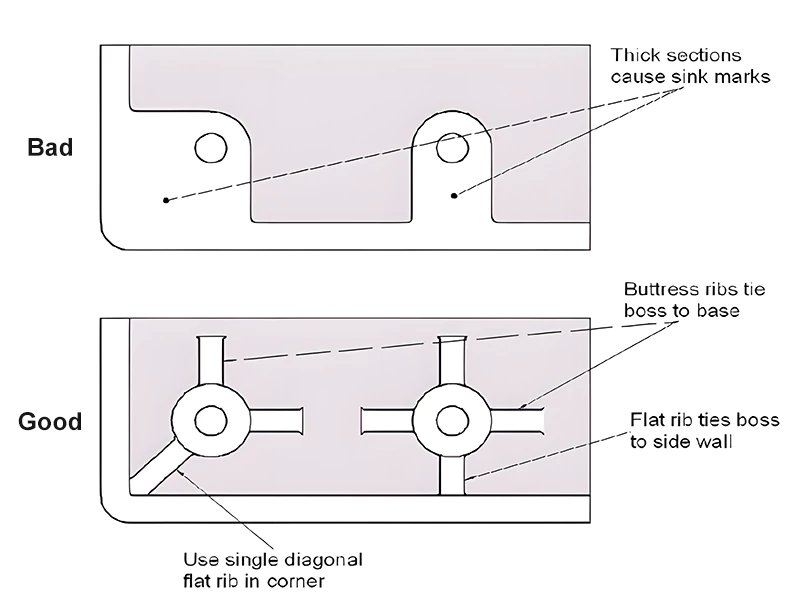
Tapones roscados para tornillos autorroscantes
Muchos resaltes se utilizan para conectar tornillos autorroscantes. Las roscas internas de estos salientes se forman mediante un proceso de flujo en frío, que deforma el plástico sin cortarlo. El tamaño del saliente roscado debe ser suficiente para soportar la fuerza de inserción del tornillo y la carga que soporta. El diámetro del orificio en el saliente debe garantizar que el tornillo permanezca seguro en condiciones específicas de par y vibración.
El diámetro exterior del resalte debe soportar sin romperse la fuerza circunferencial generada durante el apriete del tornillo. Para facilitar la inserción del tornillo, a menudo se crea un rebaje en la parte superior del resalte, ligeramente mayor que el diámetro nominal de la rosca. El cálculo de las dimensiones de un inserto puede ser complejo.
Se recomienda un método de estimación simplificado de un sitio web extranjero, basado en el diámetro nominal del tornillo. En primer lugar, identifique el material utilizado y, a continuación, aplique el coeficiente correspondiente de la tabla al diámetro nominal del tornillo para determinar el tamaño adecuado.
Conexiones Snap-Fit en el diseño de piezas de plástico
El montaje a presión es un método de conexión cómodo, rentable y respetuoso con el medio ambiente. Los componentes snap-fit se moldean simultáneamente con el producto, eliminando la necesidad de elementos de fijación adicionales como tornillos. El montaje consiste simplemente en encajar las piezas correspondientes.
El principio del encaje a presión consiste en empujar una parte saliente de un componente para que supere un obstáculo en otro componente. Este proceso implica una deformación elástica y, una vez superado el obstáculo, las piezas vuelven a su forma original y se encajan entre sí, como se muestra en la figura 9. Las conexiones a presión pueden ser permanentes o liberables. Las conexiones a presión pueden ser permanentes o liberables.

Estructuralmente, los encajes a presión pueden clasificarse en voladizo, anular y esférico, como se detalla en la figura 10.
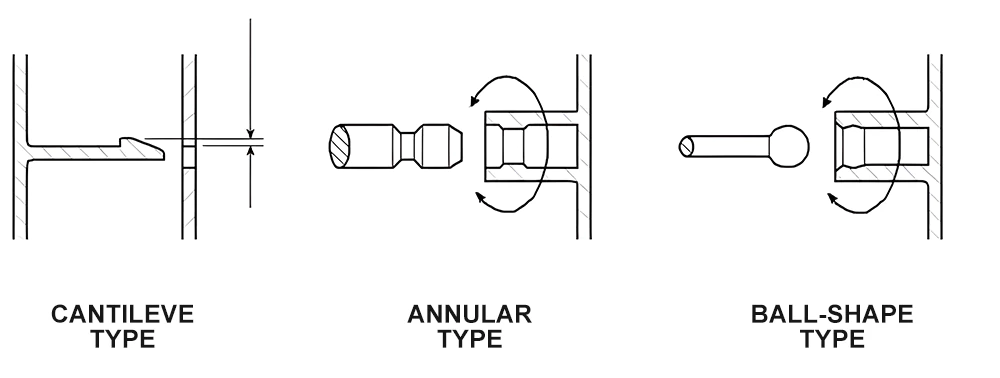
Ángulos clave y cálculos
1. Ángulos críticos
Dos ángulos críticos en el diseño de los encajes a presión son el lado de retracción y el lado de entrada. Generalmente, se prefiere un lado de retracción mayor para un ajuste más seguro. Cuando el lado de retracción se aproxima a 90 grados, el ajuste a presión se vuelve permanente, como se muestra en la figura 11.
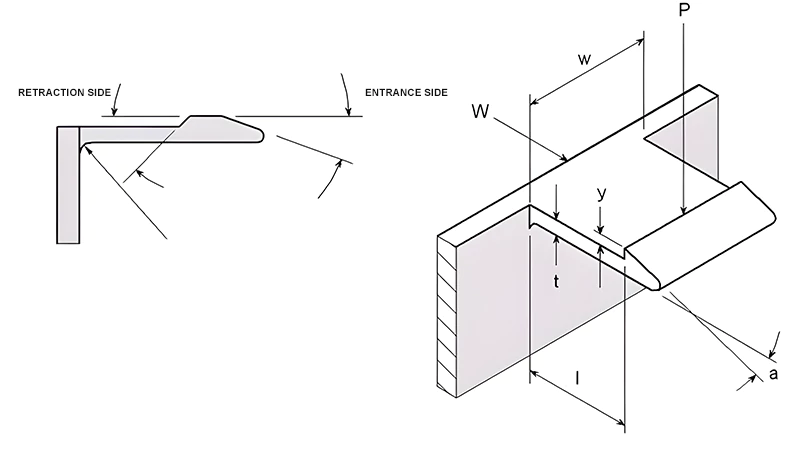
2. Cálculos para Snap-Fits
La deformación máxima admisible para un ajuste a presión de sección uniforme puede calcularse mediante: Y = el² / (1,5t). Esta fórmula supone una deformación sólo en el mosquetón. En la práctica, también se produce cierta deformación cerca del mosquetón, lo que puede considerarse un factor de seguridad.
La fuerza necesaria para producir una desviación Y en el encaje a presión: P = wt²Ee / (6l).
La fuerza de ensamblaje se puede estimar con: W = P(μ + tga) / (1 - tga).
Para los encajes a presión liberables, la fuerza de liberación puede calcularse utilizando las mismas fórmulas, sustituyendo el ángulo a por el ángulo b.
En el cuadro 2 figuran algunos coeficientes necesarios para estos cálculos.
| Materiales | (e)(%) | GPa | Coeficiente(s) de fricción |
| PS | 2 | 3.0 | 0.3 |
| ABS | 2 | 2.1 | 0.2 |
| SAN | 2 | 3.6 | 0.3 |
| PMMA | 2 | 2.9 | 0.4 |
| LDPE | 5 | 0.2 | 0.3 |
| HDPE | 4 | 1.2 | 0.3 |
| PP | 4 | 1.3 | 0.3 |
| PA | 3 | 1.2 | 0.1 |
| POM | 4 | 2.6 | 0.4 |
| PC | 2 | 2.8 | 0.4 |
3. Snap-Fits anulares
Los cierres rápidos anulares utilizan las protuberancias internas de un anillo para encajar en la ranura de un eje. En función del ángulo de liberación, pueden ser liberables o no liberables. El anillo se expande elásticamente durante la inserción y la extracción, y suele estar fabricado con materiales de buena elasticidad.
La figura 12 ilustra un encaje a presión anular.
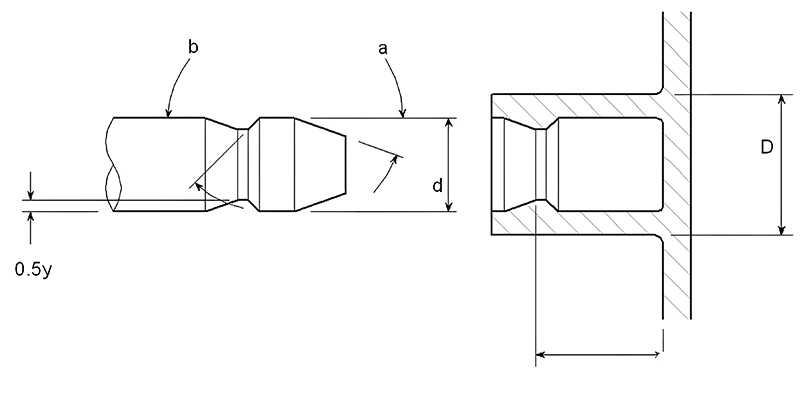
El tamaño máximo de la protuberancia del ajuste a presión anular puede calcularse utilizando:
y = Sd((K + v) / E + (1 - v) / E) / K
Donde S es la tensión de diseño, v es la relación de Poisson, E es el módulo elástico y K es un coeficiente geométrico calculado como: K = (1 + (d/D)²) / (1 - (d/D)²).
La fuerza de dilatación sobre el manguito puede calcularse con:
P = (tan a + μ) / Sydlπ / K
Donde μ es el coeficiente de rozamiento.
La Tabla 2 proporciona los coeficientes de Poisson para varios materiales sin relleno, con los coeficientes de fricción mostrados en la Figura 17.
Ajustes por interferencia en el diseño de piezas de plástico
Los ajustes de interferencia, utilizados para conectar orificios y ejes, son eficaces para transmitir par y otras fuerzas. Este tipo de conexión es cómoda y sencilla. La principal consideración a la hora de diseñar los ajustes por interferencia es la cantidad de interferencia: una interferencia demasiado pequeña da lugar a conexiones poco fiables, mientras que una interferencia demasiado grande dificulta el montaje y aumenta el riesgo de grietas.
Al diseñar los ajustes por interferencia, es importante tener en cuenta las tolerancias del orificio y el eje, así como la temperatura de funcionamiento, ya que las variaciones de temperatura pueden afectar significativamente a la cantidad de interferencia. La mayoría de los ejes son metálicos y, para garantizar una conexión fiable, es habitual añadir estrías o ranuras en el eje de acoplamiento. La fórmula general para calcular la interferencia es:
Y = Sd((K + v) / E) / K
Donde S es la tensión de diseño, v es la relación de Poisson, E es el módulo elástico y K es un coeficiente geométrico calculado como:
K = (1 + (d/D)²) / (1 - (d/D)²)
La fuerza de montaje se puede calcular con:
W = Sdlπμ / K
Donde μ es el coeficiente de fricción, y l es la longitud de enganche. La relación de Poisson se puede encontrar en la Tabla 3.
| Materiales | Relación de Poisson |
| PS | 0.38 |
| PMMA | 0.4 |
| LDPE | 0.49 |
| HDPE | 0.47 |
| PP | 0.43 |
| PA | 0.45 |
| PC | 0.42 |
| PVC | 0.42 |
| PPO | 0.41 |
| PPS | 0.42 |
| Acero | 0.38 |
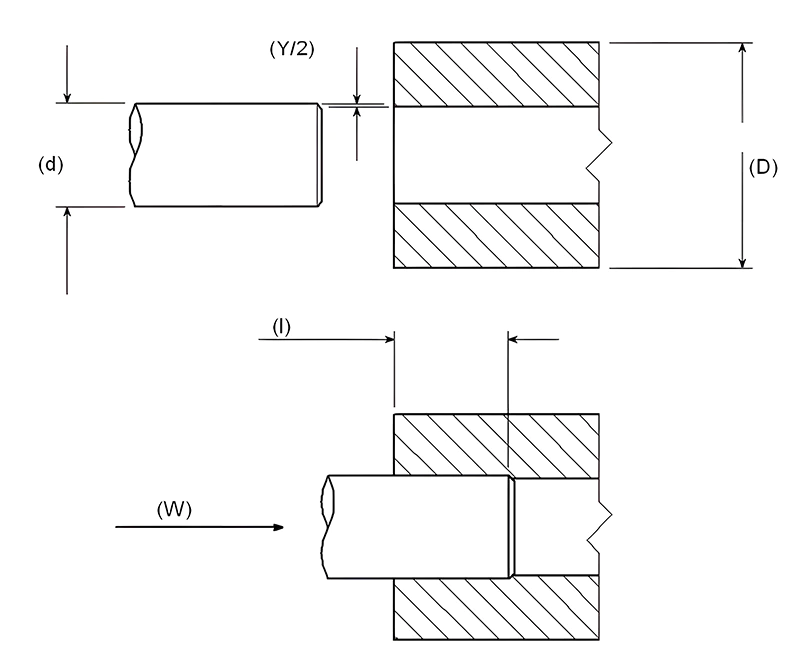
Además de los ajustes por interferencia, otros métodos para unir piezas de plástico son el termoestañado, la soldadura y la soldadura por ultrasonidos. Cada uno de estos métodos tiene sus propias ventajas y es adecuado para distintas aplicaciones en función de las propiedades del material y los requisitos del ensamblaje.
Tolerance Impact and Material Selection in Plastic Part Design
Most plastic products can achieve high precision in dimensional tolerances. However, materials with high shrinkage rates or softer materials can be more challenging to control. Product design must consider the use environment, plastic material, and product shape to set appropriate tolerances. As customer demands increase, the concept of fit and finish must evolve. The goal is to achieve a balance between fit, precision, and aesthetics.
Injection molding is generally categorized into three quality levels: general-purpose, medium precision, and high precision.
- General-Purpose Molding: This requires a lower level of quality control, characterized by lower rejection rates and faster production cycles.
- Medium Precision Molding: More expensive due to higher demands on molds and production processes, requiring frequent quality checks.
- High Precision Molding: Demands accurate molds, optimal production conditions, and continuous production monitoring. This impacts the production cycle, increasing unit production and quality control costs. Designers must balance between precision and economic production costs, often relaxing tolerances for non-critical dimensions while meeting performance, appearance, and fit requirements.
Selección de materiales
There are no inherently bad materials, only inappropriate choices for specific applications. Designers must thoroughly understand the properties of available materials and carefully test them to study their impact on the performance of molded products.
The most commonly used materials in injection molding are thermoplastics, which are divided into amorphous and semi-crystalline plastics. These two categories differ significantly in molecular structure and performance affected by crystallization. Semi-crystalline thermoplastics are typically used for parts requiring high mechanical strength, while amorphous thermoplastics, less prone to bending, are often used for casings.
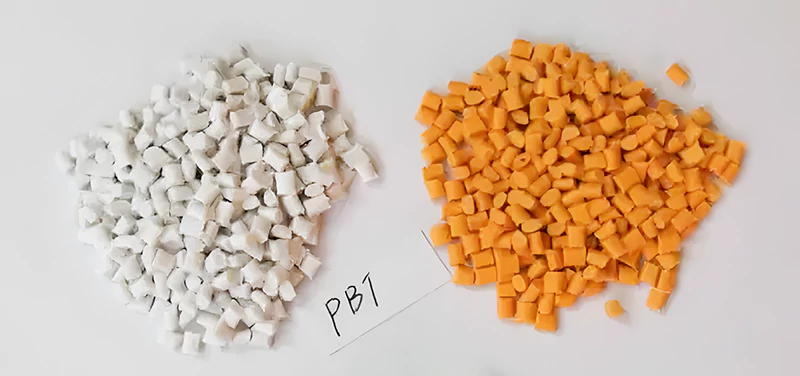
Thermoplastics are available in unreinforced, glass fiber reinforced, and mineral or glass bead filled varieties. Glass fibers mainly enhance strength, rigidity, and temperature resistance; minerals and glass fibers reduce warping but offer lower reinforcement. Specific changes in properties due to reinforcements should be confirmed with material suppliers or through experimentation.
Some thermoplastics, especially PA6 and PA66, are highly hygroscopic, which can significantly affect their mechanical properties and dimensional stability.
Considerations related to processing and assembly are crucial. Integrating multiple functions into a single component can save on costly assembly expenses. This principle is beneficial for calculating production costs. High-performance materials (rigidity, toughness) can allow for thinner walls, shortening production cycles. Therefore, listing all standards and systematically evaluating them is essential.
Fillets and Rounded Corners in Plastic Part Design
Sharp corners often lead to defects and stress concentration in plastic parts, which can cause fractures under load or impact. Larger rounded corners (fillets) offer a solution to this problem. They not only reduce stress concentration but also facilitate smoother flow of the plastic during molding and easier ejection of the finished product.
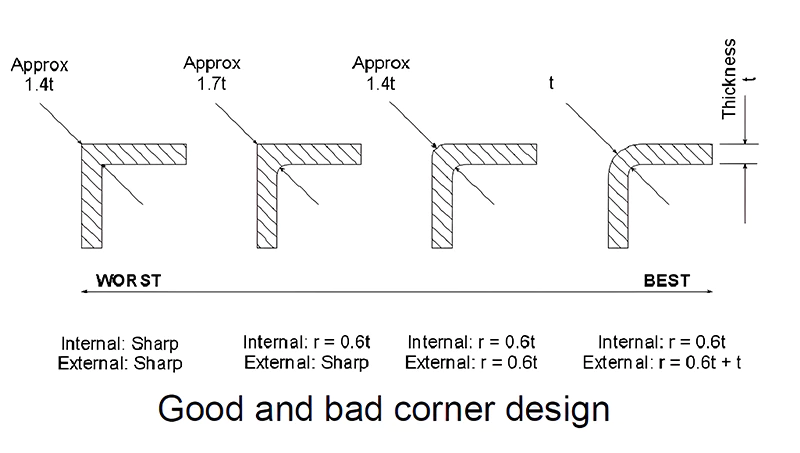
If the internal corner is rounded and the external corner is sharp, the area at the turn will still be thicker than other parts, leading to shrinkage. A solution is to round both internal and external corners to achieve uniform wall thickness. In this case, the external radius is the sum of the internal radius and the base wall thickness.
The design principles for corner radii also apply to cantilever snap-fits. In these snap-fits, the cantilever arm needs to bend and fit into place. If the radius of the corner (R) is too small, it can lead to excessive stress concentration, making the product prone to breaking when bent. Conversely, if R is too large, it can result in shrinkage marks and voids. Therefore, there is a specific ratio between the corner radius and wall thickness, typically ranging from 0.2 to 0.6, with an ideal value around 0.5.
Conclusión
In summary, this article has covered various critical aspects of structural design for injection molded parts, including wall thickness, draft angles, ribs, holes, bosses, snap-fits, interference fits, tolerances, and rounded corners. Each of these elements plays a vital role in the overall functionality, durability, and quality of the final product.
However, it’s important to remember that structural design is also influenced by environmental factors, specific conditions, and unique requirements of each project. These factors necessitate a tailored approach to each design challenge.
The goal of this comprehensive overview is to equip aspiring and practicing structural design engineers with the knowledge and insights needed to excel in their field. By understanding and applying these principles, designers can create more effective, reliable, and high-quality injection molded parts.












Un comentario
Your blog is always a highlight of my day